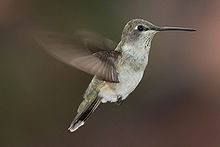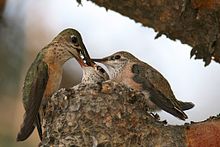
A color plate illustration from Ernst Haeckel's Kunstformen der Natur (1899), showing a variety of hummingbirds.
Hi Everybody!!
As in the real World, the 'pace' has picked up around the grounds of the Bird Sanctuary. Out there, You can only feel it. But in here, in this Spring Paradise, You can see it. You can hear it, touch it, taste it, and smell it! This early morning, I heard it! Click, click. In an instant I knew that a hummingbird had arrived! When I saw him, I was overwhelmed; it was Elvis, my favorite one! He made it back again, after a very long journey.
Sharing the great moment of first light this morning:
https://en.wikipedia.org/wiki/Hummingbird
Hummingbird
From Wikipedia, the free encyclopedia
Hummingbirds are birds that comprise the family Trochilidae. They are among the smallest of birds, most species measuring in the 7.5–13 cm (3–5 in) range. Indeed, the smallest extant bird species is a hummingbird, the 5-cm Bee Hummingbird. They hover in mid-air by rapidly flapping their wings 12–80 times per second (depending on the species). They are known as hummingbirds because of the humming sound created by their beating wings, which sometimes sounds like bees or other insects. A group of hummingbirds is called a "choir." To conserve energy while they sleep or when food is scarce, they have the ability to go into a hibernation-like state (torpor) where their metabolic rate is slowed to 1/15th of its normal rate.[1] When the nights get colder, their body temperature can drop significantly and thus slow down their heart and breathing rate, thus burning much less energy overnight. As the day heats back up, the hummingbird's body temperature will come back up and they resume their normal activity. [2] They are also the only group of birds with the ability to fly backward.[3] They can fly at speeds exceeding 15 m/s (54 km/h; 34 mph).[4] Individuals from some species of hummingbirds weigh less than a penny.
| Hummingbird | |
|---|---|
 | |
| Female Black-chinned Hummingbird | |
| Scientific classification | |
| Kingdom: | Animalia |
| Phylum: | Chordata |
| Class: | Aves |
| Subclass: | Neornithes |
| Infraclass: | Neognathae |
| (unranked): | Cypselomorphae |
| Order: | Apodiformes |
| Family: | Trochilidae Vigors, 1825 |
| Subfamilies | |
Aerodynamics of flight
Hummingbird flight has been studied intensively from an aerodynamicperspective using wind tunnels and high-speed video cameras.
Writing in Nature, the biomechanist Douglas Warrick and coworkers studied the Rufous Hummingbird, Selasphorus rufus, in a wind tunnelusing particle image velocimetry techniques and investigated the lift generated on the bird's upstroke and downstroke. They concluded that their subjects produced 75% of their weight support during the downstroke and 25% during the upstroke. Many earlier studies had assumed (implicitly or explicitly) that lift was generated equally during the two phases of the wingbeat cycle, as is the case of insects of a similar size. This finding shows that hummingbirds' hovering is similar to, but distinct from, that of hovering insects such as the hawk moths.[12]
The Giant Hummingbird's wings beat is as low as 12 beats per second, the wings of medium-sized hummingbirds beat about 20 to 30 beats per second and the smallest can reach 100 beats per second during courtship displays.
A slow motion video has shown how the hummingbirds deal with water when they are flying. To remove the water from their heads, they shake their heads and body, similar to a dog shaking to shed water.[13]
[edit]Metabolism
With the exception of insects, hummingbirds while in flight have the highest metabolism of all animals, a necessity in order to support the rapid beating of their wings. Their heart rate can reach as high as 1,260 beats per minute, a rate once measured in a Blue-throated Hummingbird.[14] They also consume more than their own weight in nectar each day, and to do so they must visit hundreds of flowers daily. Hummingbirds are continuously hours away from starving to death, and are able to store just enough energy to survive overnight.[15]
Hummingbirds are capable of slowing down their metabolism at night, or any other time food is not readily available. They enter a hibernation-like state known as torpor. During torpor, the heart rate and rate of breathing are both slowed dramatically (the heart rate to roughly 50 to 180 beats per minute), reducing the need for food.
The dynamic range of metabolic rates in hummingbirds[16] requires a corresponding dynamic range in kidneyfunction.[17] The glomerulus is a cluster of capillaries in the nephrons of the kidney that removes certain substances from the blood, like a filtration mechanism. The rate at which blood is processed is called the glomerular filtration rate (GFR). Most often these fluids are reabsorbed by the kidneys. During torpor, to prevent dehydration, the GFR slows, preserving necessities for the body such as glucose, water and salts. GFR also slows when a bird is undergoing water deprivation. The interruption of GFR is a survival and physiological mechanism unique to hummingbirds.[17]
Studies of hummingbirds' metabolisms are highly relevant to the question of how a migrating Ruby-throated Hummingbird can cross 800 km (500 mi) of the Gulf of Mexico on a nonstop flight. This hummingbird, like other birds preparing to migrate, stores up fat to serve as fuel, thereby augmenting its weight by as much as 100 percent and hence increasing the bird's potential flying time.[18]
[edit]Lifespan
Hummingbirds have long lifespans for organisms with such rapid metabolisms. Though many die during their first year of life, especially in the vulnerable period between hatching and leaving the nest (fledging), those that survive may live a decade or more. Among the better-known North American species, the average lifespan is 3 to 5 years. By comparison, the smaller shrews, among the smallest of all mammals, seldom live more than 2 years.[19] The longest recorded lifespan in the wild is that of a female Broad-tailed Hummingbird that was banded (ringed) as an adult at least one year old, then recaptured 11 years later, making her at least 12 years old. Other longevity records for banded hummingbirds include an estimated minimum age of 10 years 1 month for a female Black-chinned similar in size to Broad-tailed, and at least 11 years 2 months for a much larger Buff-bellied Hummingbird.[20]
Migration
Most hummingbirds of the U.S. and Canada migrate south in fall to spend the winter in northern Mexico or Central America. A few southern South American species also move to the tropics in the southern winter. A few species are year-round residents in the warmer coastal and southern desert regions on the USA. Among these is Rufous Hummingbird, a winter resident in Florida, parts of the Gulf coast, and up to the lowlands of coastal South Carolina/Gerogia, and Anna's Hummingbird, a common resident from California inland to southern Arizona and north to southwestern coastal British Columbia.
The Rufous Hummingbird is one of several species that breed in North America and are wintering in increasing numbers in the warm subtropical southeastern United States, rather than in tropical Mexico. The Rufous Hummingbird nests farther north than any other species and must tolerate occasional temperatures below freezing on its breeding grounds. This cold hardiness enables it to survive brief temperatures below freezing, provided that adequate shelter and feeders are available.
[edit]Superficially similar birds
Some species of sunbirds of Africa, southern and southeastern Asia, and Australia resemble hummingbirds in appearance and behavior, as do perhaps also the honeyeaters of Australia and Pacific islands. These two groups, however, are not related to hummingbirds; their resemblance is due to convergent evolution.[26]
[edit]Reproduction
As far as is known, male hummingbirds do not take part in nesting. Most species build a cup-shaped nest on the branch of a tree or shrub, though a few tropical species normally attach their nests to leaves. The nest varies in size relative to species, from smaller than half a walnut shell to several centimeters in diameter. In many hummingbird species, spider silk is used to bind the nest material together and secure the structure to its support. The unique properties of silk allow the nest to expand with the growing young. Two white eggs are laid, which, despite being the smallest of all bird eggs, are in fact large relative to the hummingbird's adult size. Incubationlasts 14 to 23 days, depending on species, ambient temperature, and female attentiveness to the nest. The mother feeds her nestlings on small arthropods and nectar by inserting her bill into the open mouth of a nestling and regurgitating the food into its crop.
[edit]Sonation during display dives
The outer tail-feathers of male Anna's Hummingbird (Calypte anna) vibrate during display dives and produce a loud chirp. When courting, the male ascends some 30m before diving over an interested female at high speed and producing a high-pitched sound. Experiments showed that the birds could not make the sound when missing their outer tail-feathers, and that those same feathers could produce the dive-sound in a wind tunnel. The bird can sing at the same frequency as the tail-feather chirp, but its weak syrinx is not capable of the same volume. Many other species of hummingbirds also produce sounds with their wings or tail, including the wings of the Broad-tailed Hummingbird, Rufous Hummingbird, Allen's Hummingbird, Streamertail, as well as the tail of the Costa's Hummingbird and the Black-chinned Hummingbird.
.
...this is brendasue signing off from Rainbow Creek. See You next time! Peace and Love-
Of course, one more great performance:
http://www.youtube.com/watch?v=emXB_CahDrsOf course, one more great performance:

https://en.wikipedia.org/wiki/File:Haeckel_Trochilidae.jpg

| This is a featured picture, which means that members of the community have identified it as one of the finest images on the English Wikipedia, adding significantly to its accompanying article. If you have a different image of similar quality, be sure to upload it using the proper free license tag, add it to a relevant article, andnominate it. |
| This image was selected as picture of the day on the English Wikipedia for July 11, 2006. |
O+O





















No comments:
Post a Comment
Hi Everybody! Please say hello and follow so I know you are here! Due to the inconsideration of people trying to put commercials on my blog comment area, I have restricted use of anonymous posts. Sorry that some hurt all.
My public email is katescabin@gmail.com No spammers or trolls